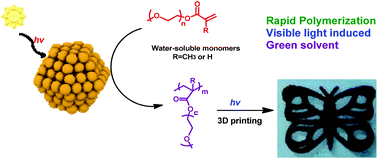Thiol ligand capped quantum dot as an efficient and oxygen tolerance photoinitiator for aqueous phase radical polymerization and 3D printing under visible light†
Abstract
We report here a rapid visible-light-induced radical polymerization in aqueous media photoinitiated by only ppm level thiol ligand capped cadmium selenide (CdSe) quantum dots (QDs). Simple ligand exchange procedures with various bifunctional thiol ligands facilitate the dispersion of CdSe QDs in water, thus expanding the scope of aqueous photocatalysts. The polymerization showcased excellent oxygen tolerance, giving a low dispersity (Đ) of 1.27. Additive thiol molecules were proposed to act as the coinitiating species, oxidized by photoexcited CdSe QDs to form thiyl radicals and further initiate the polymerization. More importantly, successful thiol–ene click reactions were achieved by scaling up the thiol to olefin ratio to 1, suggesting the thiol ligand coinitiating mechanism and meanwhile demonstrating the great potential of QD photocatalysts in organic transformations. Furthermore, the photoinitiation system using CdSe QDs could be readily employed for photo 3D printing of photocurable resin poly(ethylene glycol) diacrylates, opening up vast opportunities for fabricating advanced polymer–inorganic hybrid materials.



 Please wait while we load your content...
Please wait while we load your content...